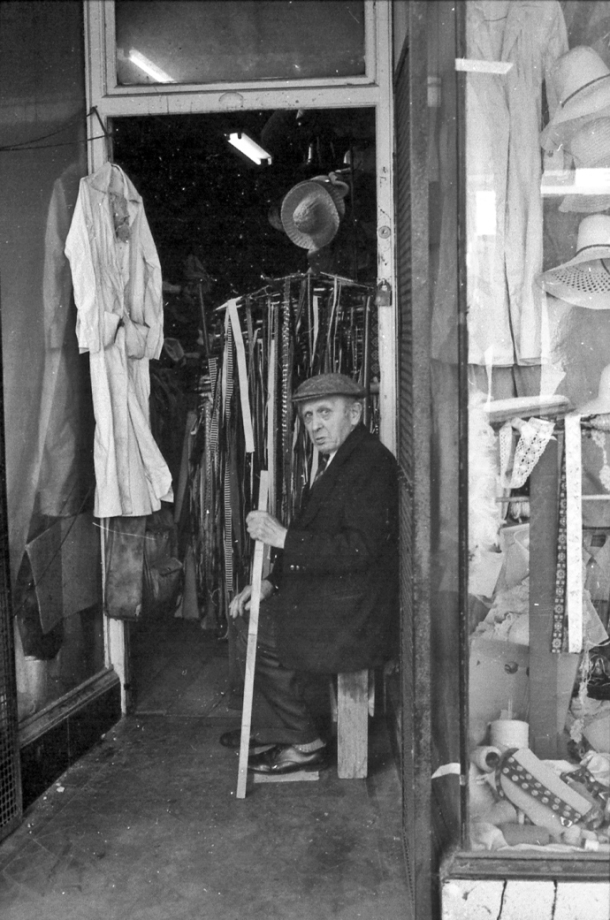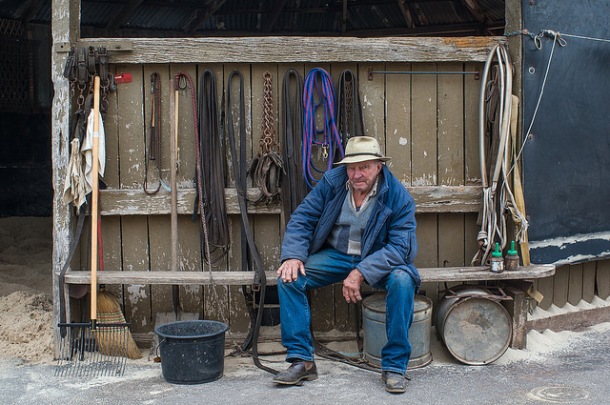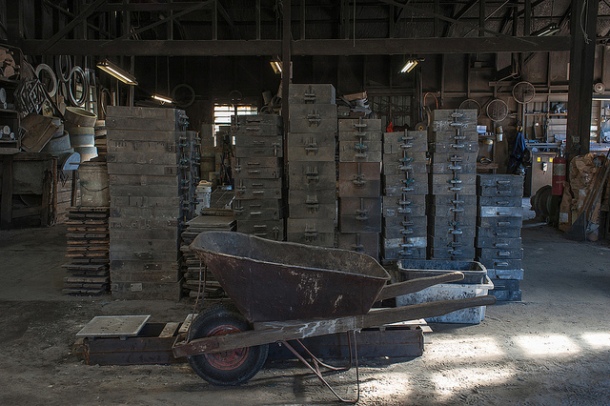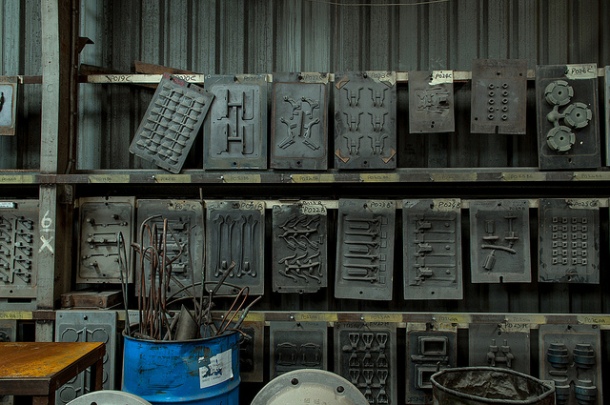ANYONE who is into photographing suburban shrubs shaped into giant kangaroos is OK with the Seeker. You could even go so for as to say that this blog has been created with just such a connoisseur of the eccentric in mind. And on that note, let me introduce you to Mr Warren Kirk, 63, of Seddon, Melbourne.
Warren is a self-confessed ‘technophobe’. He’s not on Facebook, Instagram or Twitter (although he does have a mean following on Flickr) and when I invite him onto the blog, he lets me know that he won’t be doing any interviews by email.
“More than happy to answer questions, but in the old fashioned way- so if you’re happy to give me a call I’ll talk until you tell me to shut up. Is that ok?”
As it so happens, I am more than happy to have a chat about all things eclectic and kitsch, and so begins a converstion (by phone!) with the photographer known as the Westographer, who specialises in capturing the disappearing urban landscape and characters of Melbourne’s western suburbs in all of its fading, chaotic, industrial and eccentric beauty.
Warren has amassed an impressive body of work – he estimates 20,000 photos – taken over the past three decades in Melbourne’s western suburbs.
In Westography-land, time stands still: The barber shops of old are still open; topiary gardens are in tip-top shape and the shingles still hang above the shops belonging to the last generation to have set up in Melbourne before the digital age changed everything.
But, time is running out on this era and Warren is out there every day capturing the last scenes of Australiana before the bulldozers and developers move in and the memories and advertising signs fade.
EARLY DAYS:
Warren tells me he grew up in a family more interested in sport than art, and yet it was sport that led him to his passion for photography. His love of cricket and football saw him poring over old photographs as a child: “Even as a kid I loved the nostalgia of the old cricket and football photos from the 1920’s. I was sports mad; art was never on the agenda. I didn’t consider myself an artist. I collected monographs of photographers, but I never considered I could do that.”
He went on to work in the art department on film and advertising sets and the love for nostalgia continued. As set dresser he says he loved the process of finding rare props and would also collect vintage industrial furniture that he would fix up and sell to shops.
“I live by looking in the rear vision mirror” he says.
FIRST PHOTOS:
In 1985 Warren’s girlfriend gifted him his first camera.
“She thought I might enjoy it. It was an old Pentax and I became obsessed with photography. I started shooting black and white street photography and I set up my own darkroom,” he says.
Warren would look out for events that were on – wacky things like dog shows – that he could photograph and later he graduated from black and white to colour with a Hasselblad medium format camera. He didn’t move to digital until around 2008.
“I went from more informal black and white images to using colour; having a tripod and having a specific interest in shopfronts and architecture. I was documenting stuff that was sliding into oblivion,” he says
“I’m a nostalgia-head. I guess I’m always thinking things were better back then. I loved the charm of the hand-painted signs and the faded colours. And when I went inside the shops, things hadn’t changed for 30 or 40 years.”
WESTOGRAPHY
His passion to document the western suburbs of Melbourne has seen him create a genre he calls “westography”.
“I have taken photos all over Melbourne. I keep within a small, narrow theme that you would call “social landscape”. I photograph the everyday and the mundane – I like to glorify that. I like to photograph small “h” history; people’s every day lives; the small factories and shops.
“I think there is beauty in the everyday, but people walk past and don’t notice it. I see it because it is all around me. I am really just an observer. I’m not creating, I’m observing.
“I never change anything inside a factory or shop I’m photographing; I’ll never move anything. I just frame it. I love the chaos. There’s a narrative there that brings back memories and evokes emotion.”
“I’m slightly obsessed with documenting and saving those really bad topiary and concrete gardens. They’re much more interesting to me than your average garden.
“A lot of the areas I photograph were affordable for new migrants to live and were close to industry. They used to have a lot of industry there, for example in Yarraville, but not a lot is left now. Imported goods and manufacturing being sent offshore has changed Melbourne.
“I want to capture those old shops and factories before they disappear.
“There’s a shoe repairer I photographed who has been in the same shop since 1956. You’re just not going to get that any more. Can you imagine someone having a computer repair shop for 60 years? It won’t happen.
“I love the old-school barber shops as well. They are frozen in time. One I visited hadn’t changed inside since 1959. I love walking into a place and feeling as if I’m in a time warp.”
DOCUMENTING WHAT IS DISAPPEARING
“To get my photos, I basically trawl the streets and see what attracts me. Sometimes people will ask me to photograph something – I’ve been doing some work out at Brunswick area lately and I ended up taking photographs of an Italian family making wine in the backyard.
“When I photograph, I’m very mindful that these factories and shops are workplaces. I try not to interfere and I use available lighting. When I talk to people, I tell them I love old shops and ask if I can I photograph them for my project and 99% are happy to be a part of it.
“I’m documenting what’s disappearing. There’s a foundry I’ve visited a few times in Sunshine. It’s a third-generation factory and stacked high with patterns and moulds. They can’t understand what I see in the place, but I see it as a one-of-a-kind. I look at the small, arcane working conditions and I know I wouldn’t last until morning tea working there, but to me it is beautiful; visually stunning.
“It’s the end of an era of its type and it has soul and beauty. I consider people working in those conditions as heroic.”
MELBOURNE’S CHANGING LANDSCAPE
“West Footscray has been “yuppified”. Brunswick used to have big rag-trade areas that are now developed. Yarraville is going through massive development. It has about 30 places to eat now; all these cafes and bars…
“The old Bradmill denim factory in Yarraville used to employ 3000 people; now it’s going to become a housing project.
“Some aspects get preserved, but I am sad about the beautiful buildings we have lost. But that’s the name of the game now. It’s Legoland instead.
“The beauty of the suburbs is being ripped out. Progress is inevitable, but I’m inspired to capture the last of it before it’s gone. One way or another, it will go.
“The shoe repairer who’s been there since 1956 – I don’t know how many years he’s got left in him. Those older tradies and shopkeepers won’t be replaced.”
THE FUTURE OF WESTOGRAPHY
Warren’s photos are in the State Library of Victoria’s collection and an exhibition of his earlier work called “Disappearing Victoria” was held by the library in 1998. He had his first solo show in Footscray at Post Industrial Design in 2012 and more recently his photos have appeared in Frankie magazine Excerpt magazine and in the book, Characters, Cultural Stories Revealed through Typography by Stephen Banham.
A book of his own is in the pipeline and if he has another solo exhibition, Warren says: “I’d love it to be held inside an old hall and it would be catered for by the CWA.”
Thank you for joining us on Seeker of the Lost Arts, Warren!
There is no way a blog post can do justice to his work, so I’d encourage readers to take a visit back through time and see Warren’s Westographer Flickr account for yourselves. For commissions or sales, Warren can be contacted by email: wkwirky@gmail.com
THE SEEKER SUGGESTS:
*The Seeker receives a small commission for any purchases from this link








































Thanks for sharing these great pics. I just love Warren’s work which I had seen a tiny bit of before. I too have a strong sentimental streak for all this disappearing vintage texture and I hate when it is replaced by slick and characterless perfection.
LikeLike
Thanks for commenting Susie. I, too have that sentimental streak (as you may have alreaady guessed from this blog!) Warren’s work captures it perfectly. Cheers, Megan
LikeLike
Warren is a world class photographer whose magnificent portraits and landscapes combined with a wonderful generosity in sharing his images on flickr are a constant inspiration.
LikeLike
He is very generous indeed. A champion. Thanks for visiting and commenting. Cheers, Megan
LikeLike
Terrific work I love it!
If you take a look at my website I think you’ll see why?
🙂
LikeLike
Thanks for visiting Kim! Just watched the video on your website – you and Warren are on the same page with your photography. Capturing what Warren describes as the little “h” in history. Love it.
Cheers,
Megan
LikeLike
Indeed we are Megan (and we’ve both been featured in Excerpt Magazine) 🙂 . Warren’s work is stunning he has a brilliant “eye” and that’s something that can’t be learned. Seeing this work has made my year, a friend of mine in Melbourne sent me a link to your profile on him, words just can’t describe how much I relate to Warren’s work!!
Sublime stuff …
LikeLiked by 1 person
Reblogged this on DJ Emma Peel and commented:
This is absolutely divine. If you dig old stuff like me, this blog post is highly recommended.
LikeLiked by 1 person
Glad you enjoyed Emma. Thanks for sharing the blog post, Cheers, Megan
LikeLike
Thanks for sharing this with us. I’ve just interviewed David Wadelton for 50 Lux magazine. ( 50lux.org ) David has been recording inner Melbourne since the mid 1970s. His milk bars were in Melbourne Now and his images of Northcote Houses covered the 2002 tram running on route 86.
LikeLiked by 1 person
Sounds interesting, Andrew. Thank you for visiting the Seeker! Cheers, Megan
LikeLike
David Wadelton is a fantastic photographer/artist too and has obsessively documented Northcote over a long period of time. He did a fantastic series of discarded Christmas trees and TV’s that are wonderful! 🙂
LikeLiked by 1 person
Pingback: Meet Warren Kirk | str17
love your photos Warren, from Chris Purton (previously Blue Heaven)
LikeLike
Wow. Bloody marvellous. I’m only 2.5 years into being a westie and I never want to leave. Warren is a genius. Thank you for taking his work to so many who were oblivious to it.
LikeLike
Great interview and photographs!
LikeLike
thank you so much for bringing this work to a wider audience. It is beautiful and poignant and funny and human and I adore it
LikeLike
What truly incredible work. I was pouring over every photo as there was such a story in each and every one of them. Thank you so much for sharing his work.
LikeLike
Pingback: The Week: May 16, 2014 | The Everywhereist
Hi Warren, recently saw your pic of Java Maher from Yarraville. This is my partners grandfather…. Would love a copy of that pic and have others to offer u if I retested. Hope to hear from u. Regards Karyn
LikeLike